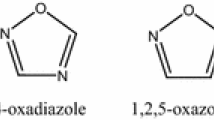Abstract
In search of new and efficient antimicrobial and anticancer agents based on the imidazoquinoline structural framework, a series of novel 7-(1-isobutyl-1H-imidazo[4,5-c]quinolin-4-yl)-7-azabicyclo[4.2.0]octa-1,3,5-trien-8-ones (8a–f) were synthesized from the corresponding 2,4-dihydroxoquinoline derivative through multistep reactions. The structures of these compounds were established by IR, 1H NMR, 13C NMR and mass spectral studies. The 7-(1-isobutyl-1H-imidazo[4,5-c]quinolin-4-yl)-7-azabicyclo[4.2.0]octa-1,3,5-trien-8-one (8a–f) analogues were evaluated for their in vitro antimicrobial activity by serial dilution method minimum inhibitory concentration (MIC). The derivatives 8c, 8e and 8f exhibited excellent antibacterial activity comparable to the parent drug ampicillin with MIC value. Compounds 7a–f and 8a–f were also assessed for their cytotoxic activity (IC50) against HeLa cells using the Trypan blue exclusion assay method. The compounds 7c and 8b displayed potential anticancer activity. In a molecular docking study, these compounds showed minimum binding energy and good affinity towards the active pocket. They are believed to be good inhibitors of β-tubulin. The results of these studies provided evidence that 7-(1-isobutyl-1H-imidazo[4,5-c]quinolin-4-yl)-7-azabicyclo[4.2.0]octa-1,3,5-trien-8-one (8a–f) derivatives are a promising class of antibacterial and anticancer agents.





Similar content being viewed by others
References
Backman GB, Bennett GE, Barker RS (1950) Synthesis of substituted quinolylamines Derivatives of 4-amino-7-chloroquinoline. J Org Chem 15:1278–1284
Boyd MR, Paull KD (1995) Some practical considerations and applications of the national cancer institute in vitro anticancer drug discovery screen. Drug Dev Res 34:91–109
Coleman PL, Crooks SL, Griesgraber GW, Lindstrom KJ, Merrill BA, Rice MJ (2000) Amide substituted imidazoquinolines WO-A-765057
Coleman PL, Crooks SL, Griesgraber GW, Lindstrom KJ, Merrill BA, Rice MJ (2003) Amide substituted imidazoquinolines US Patent-A 0144283
Freshney RI (2006) Culture of animals cells: (eds) A manual of basic technique. Wiley, Singapore
Gilchrist TL (1985) Heterocyclic chemistry the bath press ISBN 0-582-01421-2
Griesgraber GW (2004) Sulfonamide and sulfamide substituted imidazoquinolines US Patent 6,677,349
Jain PC, Kapoor V, Anand Nitya, Patnaik GK, Ahmad Allauddin, Vohra MC (1968) Chemical and pharmacological investigations of some.omega.-substituted alkylamino-3-aminopyridines. J Med Chem 11:87–92
Khan ZK (1997) In vitro and vivo screening techniques for bioactivity screening and evaluation. In: Proceeding International Workshop UNIDO-CDRI
Krepski LR, Dellaria JF, Duffy DE, Amos DT, Zimmermann BM, Squire DJ, Marszalek GJ, Heppner PD, Kshirsagar TA (2005) Hydroxylamine and oxime substituted imidazoquinolines imidazopyridines and imidazonapthyridines WO-A-051324
Loh WS, Fun HK, Reshma K, Viveka S, Nagaraja GK (2011) 1-isobutyl-N, N-1H-imidazo[4,5-c] quinolin-4-amine. Acta Crystallor E67:o406
Mackie, McCartney (1989) In: Collee JC, Duguid JP, Fraser AG, Marmion BP (eds) Practical medicinal microbiology, 13th edn. Churchil Livingstone, London
Miller RL, Gerster JF, Owens ML, Slade HB, Tomai MO (1999) Review article imiquimod applied topically: a novel immune response modifier and new class of drug Int. J Immunopharmacol 21:1–14
Ramahan AM (1999) Fused quinoline heterocycles 1. First example of the 2,4-diazidoquinoline-3-carbonitrile and 1-aryl-1,2,3,4,5,6–hexaazaacephenanthrylenes ring system. J Chem Soc Perkin Tran 1:2183–2188
Siddik ZH (2002) Mechanisms of action of cancer chemotherapeutic agents: DNA-interactive alkylating agents and antitumour platinum-based drugs. doi:10.1002/0470025077
Trevor AJ, Katzung BG, Masters SB (2010) Katzung and Trevor’s Pharmacology Examination and Board Review, 9th edn. McGraw Hill, New York, p 15
Varma RS (1998) Antifungal agents. Past, present and future prospects. National academy of chemistry and biology India, Lucknow, pp 55–128
Acknowledgments
Authors are grateful to the management of SeQuent Scientific LTD, New Mangalore, India for their invaluable support and allocation of resources for this work. Authors are also thankful to late Prof. A. Srikrishna IISc Bangalore, India for providing spectral analysis. We are also thankful Prof. H-Kun Fun for the single crystal study of the compound.
Author information
Authors and Affiliations
Corresponding author
Rights and permissions
About this article
Cite this article
Kayarmar, R., Nagaraja, G.K., Bhat, M. et al. Synthesis of azabicyclo[4.2.0]octa-1,3,5-trien-8-one analogues of 1H-imidazo[4,5-c]quinoline and evaluation of their antimicrobial and anticancer activities. Med Chem Res 23, 2964–2975 (2014). https://doi.org/10.1007/s00044-013-0885-9
Received:
Accepted:
Published:
Issue Date:
DOI: https://doi.org/10.1007/s00044-013-0885-9




